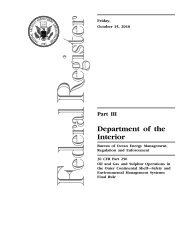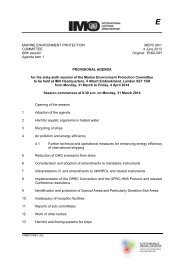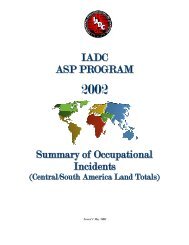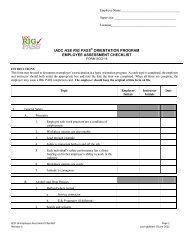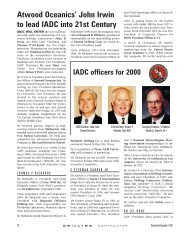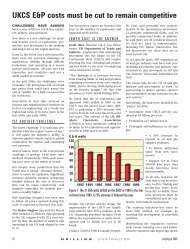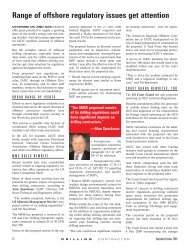Practical Field Application of the Mysterious Dynamic Kill - IADC
Practical Field Application of the Mysterious Dynamic Kill - IADC
Practical Field Application of the Mysterious Dynamic Kill - IADC
You also want an ePaper? Increase the reach of your titles
YUMPU automatically turns print PDFs into web optimized ePapers that Google loves.
<strong>Practical</strong> <strong>Field</strong> <strong>Application</strong> <strong>of</strong><br />
<strong>the</strong> <strong>Mysterious</strong> <strong>Dynamic</strong> <strong>Kill</strong><br />
Jim LaGrone, P.E.<br />
Boots & Coots<br />
Houston, Tx<br />
<strong>IADC</strong> Well Control Conference – Nov 2009
The DYNAMIC KILL<br />
• 1 st Published by Blount/Soeiinah (Mobil)<br />
• 1978 <strong>Dynamic</strong> <strong>Kill</strong> – Arun <strong>Field</strong> Indonesia<br />
– Flowing an estimated 300 MMscf/d [8.6Mm3/d]<br />
• Identified <strong>the</strong> Additional Effect <strong>of</strong> ECD<br />
– Turbulent Feature <strong>of</strong> Water<br />
• Has been used extensively, whe<strong>the</strong>r<br />
known or not<br />
• We are here to learn HOW to do it RIGHT
What is this about?<br />
• We are not here to learn about all <strong>of</strong> <strong>the</strong><br />
robust programs available to you<br />
• We are here to learn how to KILL<br />
PLAIN and SIMPLE<br />
• Problem with all SOFTWARE is…<br />
INPUT<br />
Garbage In/Garbage Out
What is IT (DK)?<br />
• Increase FBHP to SBHP via<br />
– Increasing hydrostatic head in <strong>the</strong> flow path<br />
– Increase ECD via Friction <strong>of</strong> kill fluids<br />
– Not Fracture <strong>the</strong> formation during <strong>the</strong> <strong>Kill</strong><br />
– Maintaining CONSTANT BHP once well is<br />
dead<br />
We are essentially weighting up <strong>the</strong> gas!<br />
Flow Rate = C x (SBHP 2 – FBHP 2 )
IPR<br />
Inflow Performance Releationship<br />
16,000<br />
14,000<br />
12,000<br />
Well Dead<br />
Pore Pressure<br />
FBHP (psig)<br />
10,000<br />
8,000<br />
6,000<br />
4,000<br />
2,000<br />
0<br />
0.00 20.00 40.00 60.00 80.00 100.00 120.00<br />
Flowrate (MMscf/d)<br />
AOF
Bottom Hole Pressure<br />
DP<br />
CP<br />
Static<br />
BHP
Bottom Hole Pressure<br />
DP<br />
Flowing<br />
BHP
Increasing <strong>the</strong> BHP<br />
3,500<br />
3,000<br />
SBHP<br />
BHP (psi)<br />
2,500<br />
2,000<br />
1,500<br />
1,000<br />
500<br />
0<br />
<strong>Kill</strong> Rate (BPM) 29.0<br />
Mud Density (ppg) 13.5<br />
0 200 400 600 800 1,000 1,200<br />
<strong>Kill</strong> Fluid Volume (bbl)<br />
FBHP
When is <strong>the</strong> Right<br />
Time for a<br />
<strong>Dynamic</strong> <strong>Kill</strong>?
When to USE<br />
• Anytime<br />
• There are no negatives on when to use<br />
• Limitation on tubulars (Pump Pressure)<br />
• When you SHOULD always use DK<br />
– No surface pressure control<br />
• Shallow Gas<br />
• Surface Blowout<br />
• No ability to choke well back<br />
• Worried about breaking down formation<br />
– And Having a Surface Broach
Diverted Well
Underground<br />
Blowout
The <strong>Dynamic</strong> <strong>Kill</strong><br />
Pyramid<br />
Control Parameters<br />
<strong>Kill</strong> Fluid<br />
Rate<br />
Blowout Constraints<br />
Wellbore Geometry<br />
The<br />
<strong>Kill</strong><br />
Blowout Flowrates<br />
<strong>Kill</strong> Fluid<br />
Density<br />
Injection Depth<br />
<strong>Kill</strong> Fluid<br />
Volume
The <strong>Kill</strong> Pyramid<br />
Control Parameters<br />
<strong>Kill</strong> Fluid<br />
Rate<br />
Blowout Constraints<br />
Wellbore Geometry<br />
The<br />
<strong>Kill</strong><br />
Blowout Flowrates<br />
<strong>Kill</strong> Fluid<br />
Density<br />
Injection Depth<br />
<strong>Kill</strong> Fluid<br />
Volume
Est. Flow Rate - Gas<br />
Gas Flowrate Estimated from Flame Height<br />
400<br />
350<br />
Flame Height (ft)<br />
300<br />
250<br />
200<br />
150<br />
100<br />
50<br />
0<br />
0 20 40 60 80 100 120 140 160 180 200<br />
Gas Flowrate (MMscf/d)<br />
GPSA (Sec 5-18)
Est. Flow Rate - Oil<br />
Oil Flowrate Estimated from Flame Height<br />
400<br />
350<br />
Flame Height (ft)<br />
300<br />
250<br />
200<br />
150<br />
100<br />
50<br />
0<br />
0 20,000 40,000 60,000 80,000 100,000<br />
Oil Flowrate (BOPD)<br />
Hasemi and Tojunga
Diverted Well
Sensitivities<br />
12ppg Mud <strong>Kill</strong> Rates<br />
90.0<br />
80.0<br />
70.0<br />
<strong>Kill</strong> Rate (BPM)<br />
60.0<br />
50.0<br />
40.0<br />
30 MMscf/d<br />
20 MMscf/d<br />
15 MMscf/d<br />
`<br />
10 MMscf/d<br />
∆42<br />
BPM<br />
30.0<br />
20.0<br />
10.0<br />
1,000 1,200 1,400 1,600 1,800 2,000 2,200<br />
FBHP
The <strong>Kill</strong> Pyramid<br />
<strong>Kill</strong> Fluid<br />
Rate<br />
Wellbore Geometry<br />
The<br />
<strong>Kill</strong><br />
Blowout Flowrates<br />
<strong>Kill</strong> Fluid<br />
Density<br />
Injection Depth<br />
<strong>Kill</strong> Fluid<br />
Volume
Thresholds – Fixed<br />
<strong>Kill</strong> Rate<br />
Sensitivity - Fixed <strong>Kill</strong> Rate <strong>of</strong> 64 BPM<br />
20,000<br />
18,000<br />
16,000<br />
<strong>Kill</strong> Volume (bbl)<br />
14,000<br />
12,000<br />
10,000<br />
8,000<br />
6,000<br />
4,000<br />
2,000<br />
0<br />
9 10 11 12 13 14 15 16 17<br />
<strong>Kill</strong> Mud Density (ppg)
Thresholds – Fixed<br />
Density<br />
Sensitivity - Fixed Density <strong>of</strong> 13.5 ppg (1.62 SG)<br />
<strong>Kill</strong> Volume (bbl)<br />
16,000<br />
14,000<br />
12,000<br />
10,000<br />
8,000<br />
6,000<br />
4,000<br />
2,000<br />
0<br />
30 40 50 60 70 80 90<br />
<strong>Kill</strong> Rate (BPM)
Thresholds – Fixed<br />
Volume<br />
Sensitivity - Fixed Mud Volume <strong>of</strong> 2 Hole Volumes<br />
180<br />
160<br />
140<br />
<strong>Kill</strong> Rate (BPM)<br />
120<br />
100<br />
80<br />
60<br />
40<br />
20<br />
0<br />
9 10 11 12 13 14 15 16 17<br />
<strong>Kill</strong> Mud Density (ppg)
Changing <strong>the</strong> Rules<br />
Inflow Performance<br />
3,500<br />
3,000<br />
2,500<br />
Reservoir Performance<br />
7" x 4-1/2" Annular Performance<br />
7" Casing Performance<br />
7" x 3-1/2 Annular Performance<br />
Pressure (psi)<br />
2,000<br />
1,500<br />
300 PSI @ 6 BPM<br />
7000 PSI @ 22 BPM<br />
1,000<br />
500<br />
0<br />
0 20 40 60 80 100 120 140 160<br />
Flowrate (MMscf/d)
<strong>Kill</strong> Fluid<br />
– Water<br />
• Goes into Turbulence Quickly<br />
• Cheap & Usually Plentiful<br />
• Less Polluting<br />
• High Fluid Leak-Off<br />
• Can Increase Flow Path Area<br />
– Drilling Mud<br />
• Great Fluid Leak-Off Properties<br />
• Can use Higher Densities (Pro/Con)<br />
• Does not go into Turbulence as Quickly
After <strong>Kill</strong><br />
• Water as <strong>Kill</strong> Fluid<br />
– Displace Water w/ <strong>Kill</strong> Weight Mud<br />
• Use Weight/Wait method<br />
• ECD’s must be corrected for water-mud<br />
transition<br />
• Monitor wellbore<br />
– Cement or o<strong>the</strong>r remedial operations
Real World Rules<br />
• 40% more HHP/pump rate capacity than<br />
simulated<br />
– Don’t confuse HHP w/ Rate<br />
• 100% more kill fluid volume than required<br />
• Enough fuel for double <strong>the</strong> anticipated<br />
pumping time<br />
• Start <strong>the</strong> dynamic kill job in <strong>the</strong> morning<br />
• All data acquisition into a central control<br />
cabin (BPM, Pressure, Coms, Video, BHP)<br />
• Only one person making <strong>the</strong> calls
<strong>Kill</strong> Spread
Relief Well Conduits
Surface Intervention<br />
A B C D
THE End
Any Questions?




